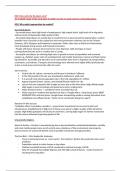EQ1: How and why do places vary?
An in-depth study of the local place in which you live or study and one contrasting place.
EQ2: Why might regeneration be needed?
Successful places:
- Successful places have high levels of employment, high output levels, high levels of in-migration,
and low levels of deprivation (high quality of life).
- Successful urban places are usually due to market forces or government-led regeneration. London
benefits from it function as the capital but also from government schemes such as the Thames
Gateway, 2012 Olympics and Heathrow’s expansion. Other cities such as Bristol and Manchester
have developed strong service and financial economies.
- People with lower incomes here tend to be more deprived, skills shortages in lower
earning/attractive jobs such as creative arts or caring.
- Successful rural places are showing high rates of growth in terms of population and economic
output e.g., Rutland. Lower rates of unemployment and smaller businesses, tourism and food can be
big industries. Accessible and attractive rural communities have seen in-migration of young families,
commuters, and retirees. Transport and technology have allowed more highly skilled professionals
to live in rural areas and travel into cities for work.
San Francisco:
Central city for culture, commerce and finance in Northern California.
In the 90s growth in the city was simulated by California’s ‘gold rush’.
It is second most densely populated city in the USA: population 8.7 million.
Appeal of good climate, culture, and relaxed lifestyle within the city.
Lots of dot-com companies like Google are here due to this who attract high skilled people.
High wages in new technology and quaternary sector employment.
Major financial centre -> considered more successful than LA.
Many long-term residents feel pushed out due to ‘Google effect’, rising house prices (RENT
INCREASE 50%) and land prices, Google buses transporting workers causing discontent from
established, less-affluent locals. “Fabric of our community being torn apart”.
Reasons for this success:
‘Multiplier effect’/cumulative causation -> government investment has occurred in jobs and
infrastructure. Establishment of high tech in these areas where a higher quality of life will attract
people. High skilled graduates will choose to work here, earning high wages for further investment
into the future ultimately improving quality of life.
Unsuccessful regions:
Spiral of decline-> Decline in manufacturing due to decentralisation and deindustrialisation, wealthy
and most mobile people more out of central areas, obsolesce of the environment and property,
poorest sectors of society left behind, lack of possible investment and opportunities.
The Rust Belt – USA: Beattyville, Kentucky:
- Town in Kentucky known as ‘coal country’, the industry’s decline has produced many social
problems.
- Population mainly in trailer homes or log cabins
- Median household income of $12k compared to national average of $54k.
- Only 5% of people had college degrees and 33% high school dropouts - needs investment
and long term education
, - High drug crime leading to many deaths.
- Male life expectancy eight years below the USA average at 68.3 and female life expectancy 5
years below at 76.4.
Detroit:
Huge deprivation following the decline of the car industry here.
- Headquarters of Quicken Loans and General Motors among other business has sparked
urban revival in the downtown.
- Cost of space and housing is much cheaper than cities like New York and Chicago.
- Lots of new attractions for younger incomes and Whole food outlets – people in housing
need this.
- Lots of bikeways, parks, and a new tram system.
- REGENERATION HAS STARTED BUT MORE NEEDS TO OCCUR.
Level of deprivation can be ranked using data made available from IMD.
Sink estates: Declining rural settlements:
High levels of economic and social deprivation Estimated 400 village shops and 700 rural pubs
and crime -> low-income groups become closed in 2010 alone. Example is Powys in Wales:
segregated due to gentrification elsewhere. 11 46.8% of their rural communities were in the top
times more likely to be unemployed. Well known 10% of deprivation in the country.
estates include Broadwater Far in Tottenham Village of Llansilin has considerable less mobile
and The Barracks in Glasgow. phone and broadband cover than the national
Regeneration will allow improvement in QoL, average, scored low on deprivation index.
employment – more taxes can cause multiplier
effect.
Gated communities: Commuter settlements
Individual buildings or groups of houses which A large proportion of the residents commute
are landscapes of surveillance, CCTV and 24/7 daily to cities for work. 2011 census 19.8 million
security, designed to deter access by unknown live in rural areas where 98% are accessible.
people and reduce crime. Replicated in the Many have moved to so called ‘wealth corridors’
redevelopment of the Docklands (London). where homes are nicer than many urban homes
and there are good transport inks for commuters
to get into cities for work. Tend to have affluent
populations and low levels of deprivation, tend
to not usually need local services than their
population suggests. Regeneration in these
places focuses on ‘affordable housing’ and
improving service provision.
Itchen Valley, Winchester:
- Accessible rural place with around 1900 residents in four adjacent villages lies at the western
end of the South Downs National Park. Scenic and ecological value with meadows and River
Itchen.
- A few miles from Winchester, M3 and fast mainline rail services to London allows it to
become a commuter hotspot, influx of younger families has helped to breathe new life.
- House and land prices rocketing, few remaining children of farmworkers unable to afford
local housing. 2015 England average was £298,313 compared to Itchen Valley £588,882.




